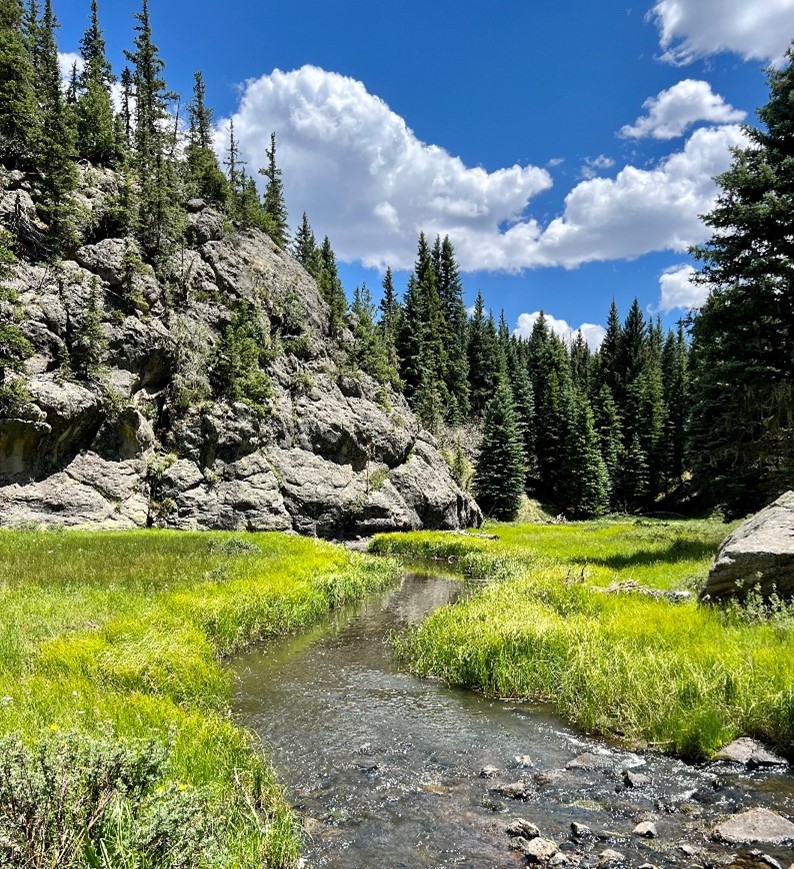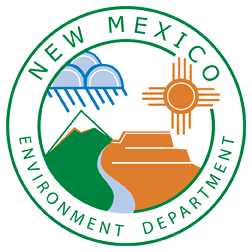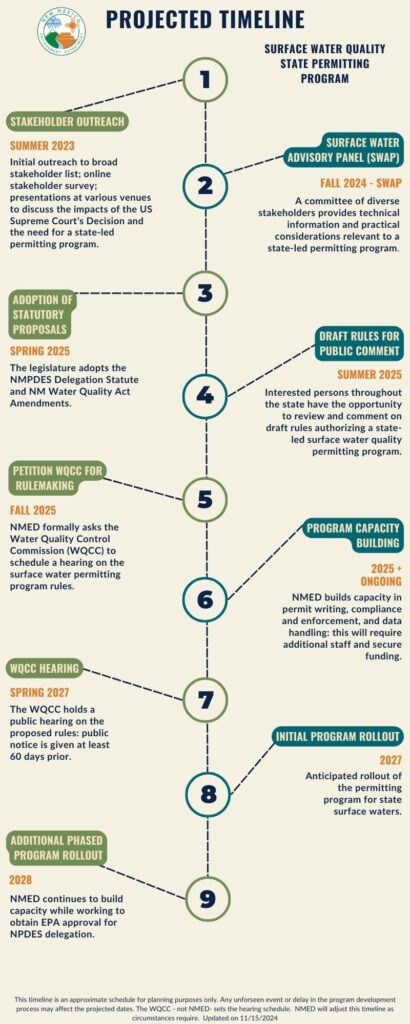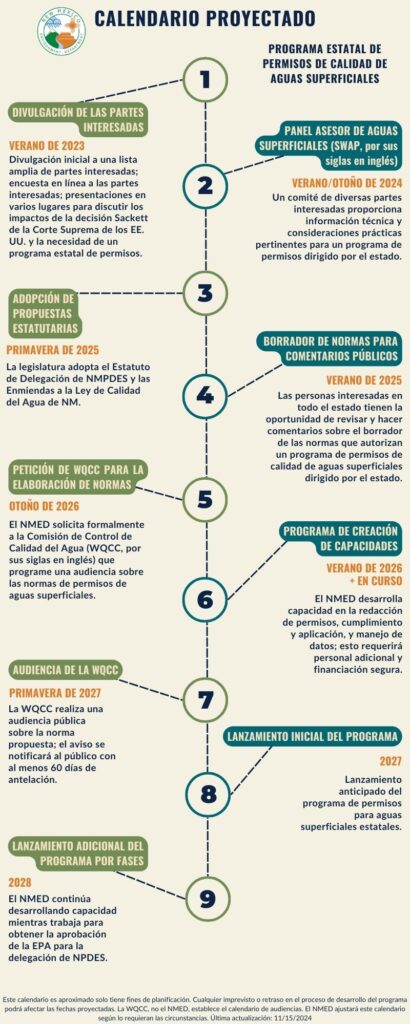
NMED is developing a State Permitting Program to protect the water quality of New Mexico’s surface waters.
Rivers, streams, lakes, wetlands, and other surface waters sustain the state’s culture, economy, and natural ecosystems. Governor Lujan Grisham in the 50 Year Water Action Plan, and the state legislature have directed the New Mexico Environment Department (NMED) to create a state permitting program to protect these waters from pollution.
Why New Mexico Needs a State Water Quality Permit Program
Currently, New Mexico relies on federal Clean Water Act permits to control the discharge of pollutants into its surface waters. Supreme Court decisions have scaled back federal jurisdiction. Recently, in the Sackett decision, the Court decided that the Clean Water Act protects only relatively permanent waters, leaving many surface waters of New Mexico at risk of contamination and degradation. To protect state waters not covered by the Clean Water Act, New Mexico must develop a state permitting program to ensure clean water for drinking, recreational, agricultural, cultural, and other uses. NMED proposes two program components:
- Delegation to implement the NPDES program that controls the discharge of pollutants into Waters of the United States covered by the federal Clean Water Act; and
- A new state permitting program to fill the gaps left by the U.S. Supreme Court’s decision in Sackett v. EPA and control the discharge of pollutants, including dredged and fill materials, into surface waters of the state, under the authority of the New Mexico Water Quality Act.
The program will not apply to discharges to tribal waters, but NMED will be responsive to tribal concerns and ensure that permitted discharges do not adversely affect tribal water quality programs.
UPDATE Adoption of Statutory Proposals- Senate Bill 21
The “Adoption of Statutory Proposals” for the Surface Water Quality State Permitting Program was scheduled for the 2025 New Mexico Legislative Session (First Session of the 57th Legislature). Senate Bill 21-Pollutant Discharge Elimination System Act and Senate Bill 22-Water Quality and Pollution were both introduced in the 2025 Legislative Session. The bills were consolidated into Senate Bill 21 and signed into law by Governor Lujan Grisham. Effective June 20th, 2025. Final Version of SB21 can be viewed here.
Further information can be found at: https://www.nmlegis.gov/Legislation/Legislation?Chamber=S&LegType=B&LegNo=21&year=25
Surface Water Advisory Panel (SWAP)
The Surface Water Advisory Panel (SWAP) met in Fall of 2024 to provide technical information, practical considerations, and policy perspectives relevant to developing and implementing a Surface Water Quality State Permitting Program. SWAP members represent a broad range of stakeholders who care about water quality protection and who may be affected by the new permitting program. To learn more about the SWAP, its members, and the input they have provided, select the link to be directed to the SWAP webpage.
Final SWAP Report Now Available for Download on SWAP Webpage
2023 New Mexico Surface Water Quality State Permitting Program Survey Results
NMED posted a brief online survey in July 2023 to better understand stakeholders’ perspectives, concerns, and questions about the idea of a state-led permitting program for surface waters. During the survey period, 416 people submitted responses. Respondents included representatives of a wide range of interests, including local governments, industry, oil and gas, environmental organizations, tribes, state and federal agencies, agriculture, irrigation districts, and outdoor recreation. However, most of the people responding to the survey categorized themselves as interested state residents (61.3%).
This early input from stakeholders is helping NMED shape options for the state-led water quality permitting program and develop informational resources to answer questions about the process.
The full “New Mexico State Surface Water Quality Permitting Program Survey: Results and Analysis” report is available here.
Key survey results
- Many respondents (82%) were very supportive of NMED taking the steps needed to develop a state-led surface water quality permitting program for New Mexico. NMED recognizes that the communication channel for alerting people about the survey opportunity – NMED water-focused email lists – reached people who were already signed up to receive water information from NMED. As a result, the people responding to the survey probably already cared a lot about water issues in New Mexico.
- Few respondents (6%) currently have a surface water quality permit. Permittees may be most directly affected by a state-led surface water quality permitting program. The survey results provide some information on how they perceive such a program, but more input from permittees is essential.
- Respondents ranked their top two benefits of a state-led surface water quality permitting program as 1) protection for all important surface waters (82%), and 2) local knowledge of New Mexico’s facilities and waters (75%). In addition to these benefits, many respondents also cited state-led enforcement (46%). These perceived benefits indicate that a state-led permitting program is needed to protect state waters that are no longer covered under the Clean Water Act.
- Most respondents shared concerns and questions about a state-led surface water quality permitting program (72%). Most of their questions and concerns fell under the category of program implementation (60%). These questions and concerns touched on issues such as staffing levels and training; inspection/compliance/enforcement; program funding and costs; permit fees and fines; monitoring; oversight; transparency; efficiency; scope of permit coverage; and effect on Tribal Nations. Regardless of level of support or stakeholder type, respondents wanted more information about the details of a state-led surface water quality permitting program.
(UPDATED) Timeline to Implementation
Further Reading and Resources
- America’s Most Endangered Rivers of 2024 featuring New Mexico
- EPA Waters of the United States – Current Definition of the Waters of the United States
- Water Quality Management Plan (WQMP) – Water quality management in New Mexico
- Thornburg Foundation 2021 NM Water Poll – Poll concerning state water resources
- Sackett v. EPA
- Story Map – New Mexico’s Clean Water Trail
- Story Map – Protect New Mexico Water
- Story Map – Wading into Wetlands of New Mexico
Frequently Asked Questions
Surface Water Quality Permitting Program FAQ
In the News
America’s Most Endangered Rivers® report, April 16, 2024
Related articles-
- “Let’s talk about endangered rivers and streams” KUNM, April 15, 2024
- “New Mexico’s rivers are most threatened waterways in US, study finds” The Guardian, April 16, 2024
- “America’s ‘most endangered rivers’ list: Sewage, toxic algae, construction feed the crisis” USA Today, April 16, 2024
- “Photos show wildlife, communities along nation’s ‘most endangered rivers’ for 2024” USA Today, April 16, 2024
- “New Mexico’s rivers named ‘most endangered’ in annual list” KRQE, April 16, 2024
- “US’s most endangered rivers are in New Mexico: Report” The Hill, April 16, 2024
- “Every New Mexico river endangered and vulnerable to contamination, according to national report” Source NM, April 17, 2024
- “American Rivers ranks waters in New Mexico as the most endangered in the country” NM Political Report, April 17, 2024
- “The Rivers of New Mexico named Most Endangered Rivers of 2024” RFDTV, April 17, 2024
- “All of New Mexico’s rivers top list for most imperiled in nation” Santa Fe New Mexican, April 22, 2024
Get Involved and Stay Informed
If you would like to be added to our project mailing list, or to contact us with feedback or questions, please send an email to swq.pp@env.nm.gov.
*Surface Water Quality Permitting Program flyers – English & Español



